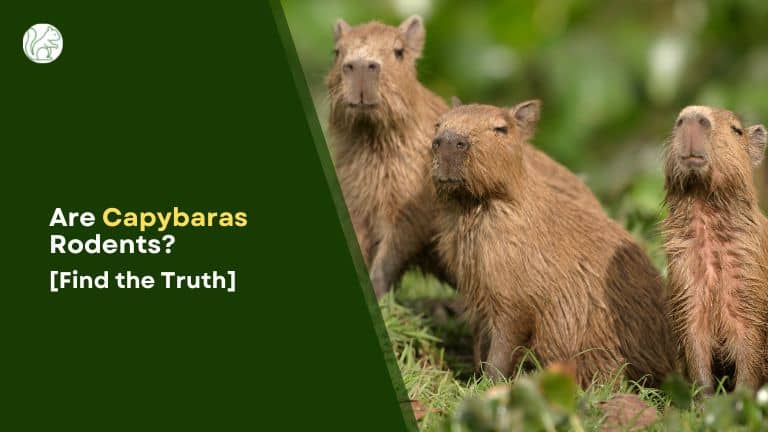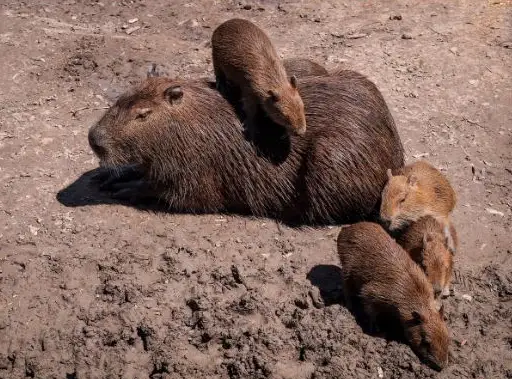With the stocky body and the furry face, you will fall in love with a capybara by seeing how cute they are. This large animal lives in South America and can live underwater for a long period!
But what is their connection to the rodents? Rodents are small, how can a capybara be a rodent? That’s completely wrong- so, is a capybara a rodent or a large guinea pig? Well, capybaras are rodents.
While we have only seen rodents like rats, mice, and squirrels, it can be difficult for us to accept that a large animal like a capybara is a rodent. Let’s learn why they are categorized as rodents!

Are Chinchillas and Capybaras Both Classified as Rodents?
Yes, both chinchillas and capybaras are classified as rodents. This chinchilla rodent truth discovery is a well-established fact in the field of zoology. Both of these adorable animals share the same classification as part of the Rodentia order, making them distant rodent cousins in the animal kingdom.
Is a Capybara a Rodent?
So, the answer is clear, capybaras are rodents. They are not just rodents but they are the largest rodents alive on planet earth. They belong to the order Rodentia and are mammals. Their family is Caviidae which includes guinea pigs, chinchillas, etc. species.
The interesting part is they are semi-aquatic and love the water. And so, you can find them near the water bodies. These species are the natives of South America.
You will find them in the dense forests close to the water bodies. They have shared features with all the rodents.
Yes, people often don’t understand that these are rodents because they can’t imagine that rodents can be this large. Their weight can be 65 pounds to 150 pounds.
And when it comes to comparing them with the other rodents, there’s no way people won’t get into a dilemma.
If you think that beavers are larger than them, let’s be clear, capybaras are larger than beavers. They both belong to the same order, and beavers are the second largest rodents in the world.
Lesser Capybara
When the name of capybara comes in, the name of Lesser capybara comes in too. There’s another species of this animal called Lesser Capybaras.
This species is a bit smaller than the actual capybaras. However, they are still big. They have a weight of 60-100 pounds.
Why are Capybaras Rodents?
We have talked about if they are rodents or not. Let’s discuss why they are rodents and what features make them so!

The Body
As we know, almost all rodents have a furry body, and so does the capybara. This species has a furry body with a brown to reddish-colored coat.
Their dense fur is just like any other rodent. They look like the larger form of guinea pigs. For your information, let’s tell you that guinea pigs are also rodents!
Incisors
Just like any other rodent, capybaras have ever-growing incisors. You will often see the capybaras chewing on things. This is to manage or maintain their everyday growing incisors.
This is a feature of any rodent- they have ever-growing incisors that keep growing throughout their life. And so, they keep chewing on things to balance it.
Diet Preference
Rodents are into plants and seeds. They also prefer eating grass and fruits or nuts. As capybaras are rodents, they too love these herbivores’ food. Capybaras are large however, they are not into meat.
Instead, they live on plants and veggies, seeds and berries, grass and nuts. As they are semi-aquatic animals, you can easily guess that they love aquatic plants.
Canines
As rodents are herbivores, they don’t have canine teeth. The basic food source for herbivores is veggies, plants, seeds, etc. as we have mentioned above.
And for chewing these, they don’t need canines. When it comes to capybaras, the situation is identical. They don’t have canine teeth to chew meat.
Wrap Up
The name of the beaver already makes us worried- how can a rodent be this large? And when you compare a beaver with a capybara, you learn that this rodent is even larger.
The best part is, they make excellent pets. All you need is to groom them and then they are yours!
